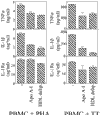The role of human T-lymphocyte-monocyte contact in inflammation and tissue destruction
- PMID: 12110136
- PMCID: PMC3240134
- DOI: 10.1186/ar558
The role of human T-lymphocyte-monocyte contact in inflammation and tissue destruction
Abstract
Contact-mediated signaling of monocytes by human stimulated T lymphocytes (TL) is a potent proinflammatory mechanism that triggers massive upregulation of the proinflammatory cytokines IL-1 and tumor necrosis factor-alpha. These two cytokines play an important part in chronic destructive diseases, including rheumatoid arthritis. To date this cell-cell contact appears to be a major endogenous mechanism to display such an activity in monocyte-macrophages. Since TL and monocyte-macrophages play a pivotal part in the pathogenesis of chronic inflammatory diseases, we investigated the possible ligands and counter-ligands involved in this cell-cell interaction. We also characterized an inhibitory molecule interfering in this process, apolipoprotein A-I. This review aims to summarize the state of the art and importance of contact-mediated monocyte activation by stimulated TL in cytokine production in rheumatoid arthritis and mechanisms that might control it.
Figures



Similar articles
-
Cytokine stimulation of T lymphocytes regulates their capacity to induce monocyte production of tumor necrosis factor-alpha, but not interleukin-10: possible relevance to pathophysiology of rheumatoid arthritis.Eur J Immunol. 1997 Mar;27(3):624-32. doi: 10.1002/eji.1830270308. Eur J Immunol. 1997. PMID: 9079801
-
Interleukin-18 enhances monocyte tumor necrosis factor alpha and interleukin-1beta production induced by direct contact with T lymphocytes: implications in rheumatoid arthritis.Arthritis Rheum. 2004 Feb;50(2):432-43. doi: 10.1002/art.20064. Arthritis Rheum. 2004. PMID: 14872485
-
Cell contact-mediated signaling of monocytes by stimulated T cells: a major pathway for cytokine induction.Eur Cytokine Netw. 2000 Sep;11(3):346-53. Eur Cytokine Netw. 2000. PMID: 11022117 Review.
-
Contact with T cells modulates monocyte IL-10 production: role of T cell membrane TNF-alpha.J Immunol. 1997 Apr 15;158(8):3673-81. J Immunol. 1997. PMID: 9103430
-
[T cell-dependent monocyte activation, TNFalpha and apolipoprotein A-I in autoimmunity and inflammation].Z Rheumatol. 2005 May;64(4):249-54. doi: 10.1007/s00393-005-0735-3. Z Rheumatol. 2005. PMID: 15909085 Review. German.
Cited by
-
Ontology and Function of Fibroblast-Like and Macrophage-Like Synoviocytes: How Do They Talk to Each Other and Can They Be Targeted for Rheumatoid Arthritis Therapy?Front Immunol. 2018 Jun 26;9:1467. doi: 10.3389/fimmu.2018.01467. eCollection 2018. Front Immunol. 2018. PMID: 29997624 Free PMC article. Review.
-
Monocytes perturbation implicated in the association of stress hyperglycemia with postoperative poor prognosis in non-diabetic patients with Stanford type-A acute aortic dissection.Cardiovasc Diabetol. 2024 Oct 26;23(1):379. doi: 10.1186/s12933-024-02468-9. Cardiovasc Diabetol. 2024. PMID: 39462406 Free PMC article.
-
The T cell cometh: interplay between adaptive immunity and cytokine networks in rheumatoid arthritis.J Clin Invest. 2004 Aug;114(4):471-4. doi: 10.1172/JCI22651. J Clin Invest. 2004. PMID: 15314683 Free PMC article. Review.
-
The role of microbiome in rheumatoid arthritis treatment.Ther Adv Musculoskelet Dis. 2019 Jul 30;11:1759720X19844632. doi: 10.1177/1759720X19844632. eCollection 2019. Ther Adv Musculoskelet Dis. 2019. PMID: 31431810 Free PMC article. Review.
-
Glatiramer acetate increases IL-1 receptor antagonist but decreases T cell-induced IL-1beta in human monocytes and multiple sclerosis.Proc Natl Acad Sci U S A. 2009 Mar 17;106(11):4355-9. doi: 10.1073/pnas.0812183106. Epub 2009 Mar 2. Proc Natl Acad Sci U S A. 2009. PMID: 19255448 Free PMC article.
References
-
- Vey E, Zhang JH, Dayer J-M. IFN-gamma and 1,25(OH)2D3 induce on THP-1 cells distinct patterns of cell surface antigen expression, cytokine production, and responsiveness to contact with activated T cells. J Immunol. 1992;149:2040–2046. - PubMed
-
- Isler P, Vey E, Zhang JH, Dayer JM. Cell surface glycoproteins expressed on activated human T-cells induce production of interleukin-1 beta by monocytic cells: a possible role of CD69. Eur Cytokine Netw. 1993;4:15–23. - PubMed
-
- Lacraz S, Isler P, Vey E, Welgus HG, Dayer JM. Direct contact between T lymphocytes and monocytes is a major pathway for induction of metalloproteinase expression. J Biol Chem. 1994;269:22027–22033. - PubMed
Publication types
MeSH terms
LinkOut - more resources
Full Text Sources
Medical

